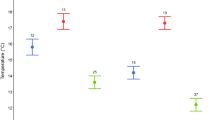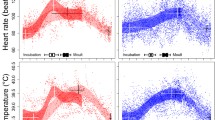Summary
In some reptiles, gravid females bask more, and/or maintain higher body temperatures than do males or non-gravid females. This phenomenon is usually explained in terms of the female or her offspring benefitting from accelerated embryogenesis and early birth, but the effect of increased basking on gestation period has not been studied. In a laboratory experiment, gestation periods of gravid female skinks (Eulamprus tympanum) decreased with the duration of access to radiant heat. Embryonic development was more rapid in the laboratory than in the field, and there were no apparent adverse effects of this accelerated gestation on females or offspring. Number and mass of offspring, survival rates of embryos, relative clutch mass and female mass before and after parturition were not influenced by the decrease in gestation period caused by increased basking. Females selected similar temperatures in the laboratory and field (32° C), despite the availability of higher temperatures in the laboratory. Thus, gestation in the laboratory was accelerated by spending longer periods at usual basking temperatures, rather than by selecting higher temperatures. In the field, mean and modal body temperatures of active animals were similar in gravid females, males and non-gravid females, but gravid females appear to bask more of the time, even in cloudy weather when other members of the population do not bask. Hence, an apparent similarity in thermal regimes of gravid and non-gravid animals may mask significant underlying differences in thermoregulatory strategies.
Similar content being viewed by others

References
Beuchat CA (1986) Reproductive influences on the thermoregulatory behaviour of a live-bearing lizard. Copeia 1986:971–979
Beuchat CA (1988) Temperature effects during gestation in a viviparous lizard. J Therm Biol 13:135–142
Charland MB, Gregory PT (1990) The influence of female reproductive status on thermoregulation in a viviparous snake, Crotalus viridis. Copeia 1990:1059–1068
Defaure JP, Hubert J (1961) Table de développement du lézard vivipare: Lacerta (Zootoca) vivipara Jaquin. Arch Anat Microscop Morphol Exp 50:309–328
Gibson R, Falls JB (1979) Thermal biology of the common garter snake Thamnophis sirtalis (L.) 1. Temporal variation, environmental effects and sex differences. Oecologia 43:79–97
Hirth HF, King AC (1969) Body temperatures of snakes in different seasons. J Herpetol 3:101–102
Huey RB (1982) Temperature, physiology, and the ecology of reptiles. In: Gans C, Pough FH (eds) Biology of the Reptilia, Vol. 12. Academic Press London, pp 25–91
Miller K, Packard GC, Packard MJ (1987) Hydric conditions during incubation influence locomotor performance of hatchling snapping turtles. J Exp Biol 127:401–412
Muth A (1980) Physiological ecology of desert iguana (Dipsosaurus dorsalis) eggs: temperature and water relations. Ecology 61:1335–1343
Pollock KH, Nichols JD, Brownie C, Hines JE (1990) Statistical inference for capture-recapture experiments. Wildl Monogr 107:1–97
Ruby DE (1977) Winter activity in Jarrow's spiny lizard, Sceloporus jarrovi. Herpetologica 33:322–332
Schwarzkopf L (1991) Costs of reproduction in the viviparous skink, Eulamprus tympanum. Ph.D. Dissertation, University of Sydney, NSW, Australia
Seigel RA, Fitch HS (1984) Ecological patterns of relative clutch mass in snakes. Oecologia 61:293–301
Shine R (1980) “Costs” of reproduction in reptiles. Oecologia 46:92–100
Shine R, Lambeck R (1990) Seasonal shifts in the thermoregulatory behaviour of Australian blacksnakes, Pseudechis porphyriacus (Serpentes: Elapidae). J Therm Biol 15:301–305
Sokal RR, Rohlf FJ (1981) Biometry, 2nd Edn. W.H. Freeman and Co. New York
Spellerberg IF (1972) Thermal ecology of allopatric lizards (Sphenomorphus) in southeast Australia. I. The environment and lizard critical temperatures. Oecologia 9:371–383
Stewart JR (1984) Thermal biology of the live bearing lizard Gerrhonotus coeruleus. Herpetologica 40:349–355
Tinkle DW (1969) The concept of reproductive effort and its relation to the evolution of life histories of lizards. Am Nat 103:501–516
Veron JEN (1969) The reproductive cycle of the water skink, Sphenomorphus quoyii. J Herpetol 3:55–63
Author information
Authors and Affiliations
Rights and permissions
About this article
Cite this article
Schwarzkopf, L., Shine, R. Thermal biology of reproduction in viviparous skinks, Eulamprus tympanum: why do gravid females bask more?. Oecologia 88, 562–569 (1991). https://doi.org/10.1007/BF00317720
Received:
Accepted:
Issue Date:
DOI: https://doi.org/10.1007/BF00317720



